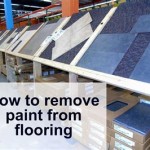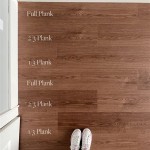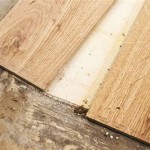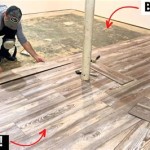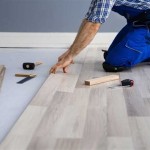How Flat Does a Floor Have To Be For Tile?
Installing tile flooring is a significant undertaking, offering durability, aesthetic appeal, and a variety of design options. However, the success of any tile installation hinges critically on the flatness of the subfloor. A subfloor that deviates significantly from a level plane can lead to a host of problems, impacting not only the visual outcome but also the structural integrity and longevity of the tiled surface. This article will explore the specific flatness requirements for tile installation, the consequences of neglecting these requirements, and the methods used to assess and rectify subfloor imperfections.
Understanding Flatness Tolerances for Tile
The generally accepted industry standard for subfloor flatness when installing tile is that there should be no more than 1/4 inch deviation in a 10-foot span and no more than 1/8 inch deviation in a 2-foot span. These tolerances are crucial because they directly affect the ability of the tile to adhere properly to the substrate and distribute weight evenly. Exceeding these tolerances can lead to cracked tiles, grout failure, and an overall unstable floor surface. It is important to note that these tolerances apply to both concrete and wood subfloors, although the methods of achieving the required flatness may differ.
These specifications are often cited in installation guides provided by tile manufacturers and are also referenced in standards set by organizations like the Tile Council of North America (TCNA). Adhering to these guidelines is not merely a suggestion; it is a fundamental requirement for ensuring a successful and lasting tile installation. Failing to meet these flatness requirements can void warranties and lead to costly repairs down the line.
The specific type of tile being installed can also influence the acceptable flatness tolerances. Larger format tiles, for instance, are generally more sensitive to variations in the subfloor because their size amplifies any imperfections. Smaller tiles are more forgiving, as they can conform slightly to minor undulations in the surface. However, even with smaller tiles, exceeding the stated flatness requirements is not advisable.
Consequences of an Uneven Subfloor
The ramifications of installing tile over a subfloor that does not meet the required flatness standards are numerous and can be quite detrimental. One of the most common issues is tile cracking. When tiles are laid over an uneven surface, they are subjected to uneven stress. This stress is amplified when the floor is subjected to weight or impact. Over time, this localized stress can cause the tiles to crack, requiring replacement and undermining the overall aesthetic of the floor.
Another significant problem is grout failure. Grout acts as a buffer between the tiles, absorbing movement and preventing friction that could lead to chipping or cracking. However, if the subfloor is uneven, the grout lines will be subjected to varying degrees of compression and tension. This uneven stress can cause the grout to crack, crumble, and eventually fall out. Grout failure not only detracts from the appearance of the floor but also allows water to penetrate beneath the tiles, potentially damaging the subfloor and leading to mold growth.
Furthermore, an uneven subfloor can result in lippage, which refers to the height difference between adjacent tiles. Lippage is not only unsightly but also presents a tripping hazard. It can also make cleaning the floor more difficult, as dirt and debris tend to accumulate in the uneven grout lines. In severe cases, lippage can even damage wheeled objects, such as wheelchairs or rolling carts.
In addition to these aesthetic and functional issues, an uneven subfloor can also compromise the structural integrity of the entire floor assembly. If the tiles are not properly supported, they can become loose over time, creating a hollow sound when walked upon. This looseness can eventually lead to the tiles becoming completely detached from the subfloor, requiring a complete replacement of the tiled surface.
Methods for Assessing and Correcting Subfloor Flatness
Before embarking on any tile installation project, it is essential to thoroughly assess the flatness of the subfloor. There are several methods for doing this, ranging from simple visual inspections to more sophisticated techniques using specialized tools. A simple visual inspection can often reveal obvious dips, humps, and other irregularities in the surface. However, this method is not sufficient for determining whether the subfloor meets the required flatness tolerances.
A more accurate method involves using a long straightedge, typically 6 to 10 feet in length. The straightedge is placed on the subfloor in various directions, and a level is used to check for any gaps between the straightedge and the surface. A feeler gauge can then be used to measure the size of any gaps, allowing you to determine whether the subfloor falls within the acceptable flatness tolerances. This method is relatively simple and inexpensive, but it requires careful attention to detail to ensure accurate measurements.
For larger areas or more complex subfloor conditions, a laser level can be a more efficient and accurate tool. A laser level projects a perfectly level line onto the surface of the subfloor, allowing you to quickly identify any areas that deviate from the plane. The laser beam can be scanned across the entire area, providing a comprehensive assessment of the subfloor's flatness.
Once the subfloor has been assessed, the next step is to correct any imperfections that exceed the acceptable flatness tolerances. The specific method used to correct the subfloor will depend on the type of subfloor material (concrete or wood) and the nature of the imperfections. For concrete subfloors, minor imperfections can often be corrected using a self-leveling underlayment. This material is a pourable mixture that spreads out to create a perfectly level surface. It is important to choose a self-leveling underlayment that is specifically designed for use under tile, as not all self-leveling products are suitable for this application.
For larger imperfections in concrete subfloors, it may be necessary to use a grinding machine to remove high spots. Grinding can be a messy and time-consuming process, but it is often the most effective way to achieve the required flatness. Conversely, low spots can be filled with a patching compound or a cement-based mortar. It is essential to allow the patching compound or mortar to fully cure before proceeding with the tile installation.
For wood subfloors, shimming is a common method for correcting minor imperfections. Shims are thin pieces of wood or plastic that are placed under the subfloor to raise it to the desired level. For larger imperfections, it may be necessary to reinforce the subfloor with additional layers of plywood or to replace damaged or warped sections of the subfloor entirely. It is crucial to ensure that the subfloor is securely fastened to the joists before installing the tile, as any movement in the subfloor can lead to cracked tiles and grout failure.
Regardless of the method used to correct the subfloor, it is essential to re-check the flatness after the corrections have been made. This will ensure that the subfloor now meets the required flatness tolerances and that the tile installation will be successful. Failing to thoroughly assess and correct the subfloor can lead to significant problems down the line, so it is worth taking the time to do the job right the first time.
The Importance of Considering the Tile Type and Size
As previously alluded to, the type and size of the tile being installed influence the criticality of subfloor flatness. Large format tiles, especially those exceeding 12 inches in any dimension, demand a more precise and level subfloor than smaller tiles. The larger the tile, the less forgiving it is to irregularities. Deviations in the subfloor are readily apparent with large format tiles, leading to visible lippage, uneven grout lines, and a generally unappealing result. The weight distribution across a larger tile also places more stress on the adhesion layer, increasing the risk of cracking if the subfloor is not sufficiently flat.
Thin-set mortar, the adhesive used to bond the tile to the subfloor, has limited capacity to compensate for unevenness. While it can fill minor gaps, it is not designed to bridge significant height differences. Attempting to compensate for an uneven subfloor with excessive thin-set can lead to weak bonds, uneven curing, and ultimately, tile failure. Moreover, thicker layers of thin-set can shrink during the drying process, creating additional stresses on the tile and grout.
Certain types of tile, such as natural stone tiles, possess inherent variations in thickness and surface texture. While these variations contribute to the unique character of the stone, they also make it more challenging to achieve a perfectly flat surface, even with a level subfloor. Careful attention to detail is required when installing natural stone tiles, including sorting the tiles by thickness and using appropriate shimming techniques to minimize lippage.
Therefore, prior to commencing any tile installation project, it is imperative to consider the specific characteristics of the tile being used. If large format tiles or sensitive materials like natural stone are involved, extra care must be taken to ensure that the subfloor meets the most stringent flatness requirements. This may involve more extensive subfloor preparation, the use of specialized leveling compounds, and meticulous attention to detail during the installation process.
.jpg?strip=all)
Is Your Floor Or Wall Flat Enough For Large Format Tile

How To Prepare A Subfloor For Tile Installation The Home

How To Prepare A Subfloor For Tile Installation The Home

Is Your Floor Or Wall Flat Enough For Large Format Tiles

If The Floor Is Not Flat Fix It Trends Installation

Is Your Floor Or Wall Flat Enough For Large Format Tiles

Technical Focus Achieving A Flat Floor For Tile And Stone S 2024 06 14 Trends Installation

How To Prep Floors For Tile Make It Flat

Astm F 710 Does The Subfloor Need To Be That Flat Floor Consult

Critical Points Of Ceramic Tile Design And Installation Mortar Bed Mud Floors Walls Floor Trends
See Also

